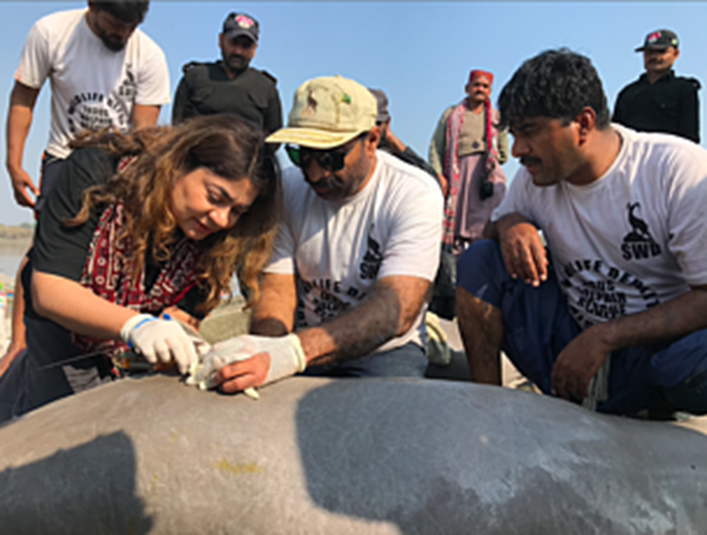First ever Ganges river dolphin (Platanista gangetica) was tagged in Assam, in what is being deemed as a historic milestone for Project Dolphin, the movement aimed towards conserving India’s National Aquatic Animal. The tagging exercise will help in understanding the species’ seasonal and migratory patterns, range, distribution, and habitat utilisation, particularly in fragmented or disturbed river systems, according to the press release by the Ministry of Environment, Forest and Climate Change.
India Conducts First Ever Ganges River Dolphin Tagging In Assam
Why In News
- First ever Ganges river dolphin (Platanista gangetica) was tagged in Assam, in what is being deemed as a historic milestone for Project Dolphin, the movement aimed towards conserving India’s National Aquatic Animal. The tagging exercise will help in understanding the species’ seasonal and migratory patterns, range, distribution, and habitat utilisation, particularly in fragmented or disturbed river systems, according to the press release by the Ministry of Environment, Forest and Climate Change.
About Gangetic Dolphins
- Gangetic River Dolphin (scientific name Platanista gangetica) is also known as the blind dolphin, Ganges susu or Hihu’s.
- According to the Wildlife Institute of India, there are around 4000 River Dolphins in India, of which around 2000 are found in Uttar Pradesh.
- The River Dolphin is not a fish but a mammal.
- They are found in certain stretches of India’s Ganga-Brahmaputra-Barak river system, Nepal’s Karnali, Sapta Koshi, and Narayani rivers, and Bangladesh’s Meghna, Karnaphuli, and Sangu rivers.
- The Gangetic River Dolphins are mainly found in the mainstream of the Ganga River and its tributaries, Ghaghra, Kosi, Gandak, Chambal, Rupnarayan, and Yamuna. They go by a number of local names across their range including susu, soons, soans, or soos in Hindi, shushuk in Bengali, hiho or hihu in Assamese, and bhagirath, shus or suongsu in Nepali. Culturally, the species is often associated with Ganga and is occasionally depicted as the vahana (vehicle) of Goddess Ganga.
Aim Of The Tagging
- Tagging of wildlife animals is one of the most preferred tools amongst wildlife scientists and conservationists to understand the movement and habitat of wildlife animals.
- The Gangetic River Dolphin surfaces only for 5.30 seconds at a time. This makes it very difficult for conservationists to study their ecological needs scientifically.
- To fill this knowledge gap, satellite-based tagging of the Dolphin has been done.
- Scientists will now be able to gather real-time data on Dolphins’ preferred migratory routes, habitats, distribution range and potential threats they face along their routes.
- This will help conservationists devise a better conservation plan for the Dolphins.
- Gangetic River Dolphins are indicators of a healthy river ecosystem and are considered crucial for the Gangetic ecosystem.
- The lightweight tags are designed to emit signals that will be picked up by satellites when these species surface, which “will contribute to evidence-based conservation strategies that are urgently needed for this species,” Virendra R Tiwari, director of the Wildlife Institute of India said.
- Notably, Project Dolphin views the Gangetic river dolphin as an “umbrella species” whose conservation “will contribute to the wellbeing of associated habitat and biodiversity, including humans”.
Attempts At Conservation
- Since the 1980s, various efforts have been made to conserve the elusive species, and restore its population to pre-20th century levels. But so far, these efforts have not borne much fruit.
- Wildlife Act Protection : After the launch of Ganga Action Plan in 1985, the government in 1986 included Gangetic dolphins in the First Schedule of the Indian Wildlife (Protection) Act, 1972. This was aimed at checking hunting and providing conservation facilities such as wildlife sanctuaries for the species. For instance, the Vikramshila Ganges Dolphin Sanctuary was established in Bihar under this Act.
- Conservation Plan : The government prepared The Conservation Action Plan for the Ganges River Dolphin 2010-2020, which “identified threats to Gangetic Dolphins and impact of river traffic, irrigation canals and depletion of prey-base on Dolphins populations”. The idea was to holistically identify factors that were leading to the species population declining, and address these issues.
- National Aquatic Animal: In 2009, then Prime Minister Manmohan Singh, declared the Gangetic river dolphin as the National Aquatic Animal of India, in what was an attempt to boost awareness of the species and community participation in its conservation.
- Project Dolphin : This is the latest effort to aid the species’ conservation, launched by Prime Minister Narendra Modi in 2020. While announcing the project, Modi said that this project will be on the lines of Project Tiger, which has been successful in reviving the tiger population in the country.





























